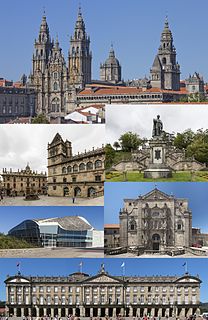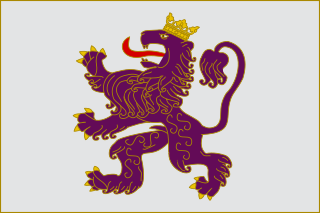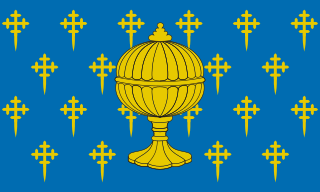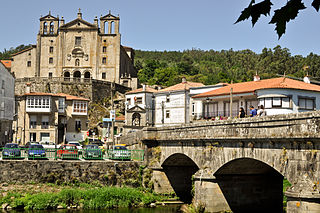
Galicia is an autonomous community of Spain and historic nationality under Spanish law. Located in the northwest Iberian Peninsula, it includes the provinces of A Coruña, Lugo, Ourense and Pontevedra.

Santiago de Compostela is the capital of the autonomous community of Galicia, in northwestern Spain. The city has its origin in the shrine of Saint James the Great, now the Cathedral of Santiago de Compostela, as the destination of the Way of St. James, a leading Catholic pilgrimage route since the 9th century. In 1985, the city's Old Town was designated a UNESCO World Heritage Site.

Ferdinand II, was a member of the Castilian cadet branch of the House of Ivrea and King of León and Galicia from 1157 until his death.

The Kingdom of Asturias was a kingdom in the Iberian Peninsula founded by the Visigothic nobleman Pelagius. It was the first Christian political entity established after the Umayyad conquest of Visigothic Hispania in 718 or 722. That year, Pelagius defeated an Umayyad army at the Battle of Covadonga, in what is usually regarded as the beginning of the Reconquista.

Alfonso III, called the Great, was the king of León, Galicia and Asturias from 866 until his death. He was the son and successor of Ordoño I. In later sources he is the earliest to be called "Emperor of Spain." He was also titled "Prince of all Galicia".

The Kingdom of León was an independent kingdom situated in the northwest region of the Iberian Peninsula. It was founded in 910 when the Christian princes of Asturias along the northern coast of the peninsula shifted their capital from Oviedo to the city of León. The kings of León fought civil wars, wars against neighbouring kingdoms, and campaigns to repel invasions by both the Moors and the Vikings, all in order to protect their kingdom's changing fortunes.
This is a historical timeline of Portugal.
This is a historical timeline of Portugal.

The Iberian Peninsula has been inhabited for at least 500,000 years, first by Neanderthals and then by modern humans.

The Kingdom of Galicia was a political entity located in southwestern Europe, which at its territorial zenith occupied the entire northwest of the Iberian Peninsula. It was founded by the Suebic king Hermeric in 409, with its capital established in Braga. It was the first kingdom that officially adopted Catholicism. In 449, it minted its own currency. In 585, it became a part of the Visigothic Kingdom. In the 8th century, Galicia became a part of the newly founded Christian Kingdom of Asturias, which later became the Kingdom of León, while occasionally achieving independence under the authority of its own kings. Compostela became the capital of Galicia in the 11th century, while the independence of Portugal (1128) determined its southern boundary. The accession of Castilian King Ferdinand III to the Leonese kingdom in 1230 brought Galicia under the control of the Crown of Castile.

Padrón is a concello in the Province of A Coruña, in Galicia (Spain) within the comarca of O Sar. It covers an area of 48.4 km², is 95 km from A Coruña and 23km from Santiago de Compostela. As of 2009, had a population of 8968 according to the INE. Padrón is divided into five parishes:

Normandy was a province in the North-West of France under the Ancien Régime which lasted until the latter part of the 18th century. Initially populated by Celtic tribes in the West and Belgic tribes in the North East, it was conquered in AD 98 by the Romans and integrated into the province of Gallia Lugdunensis by Augustus. In the 4th century, Gratian divided the province into the civitates that constitute the historical borders. After the fall of Rome in the 5th century, the Franks became the dominant ethnic group in the area and built several monasteries. Towards the end of the 8th century, Viking raids devastated the region, prompting the establishment of the Duchy of Normandy in 911. After 150 years of expansion, the borders of Normandy reached relative stability. These old borders roughly correspond to the present borders of Lower Normandy, Upper Normandy and the Channel Islands. Mainland Normandy was integrated into the Kingdom of France in 1204. The region was badly damaged during the Hundred Years War and the Wars of Religion, the Normans having more converts to Protestantism than other peoples of France. In the 20th century, D-Day, the 1944 Allied invasion of Western Europe, started in Normandy. In 1956, mainland Normandy was separated into two regions, Lower Normandy and Upper Normandy, which were reunified in 2016.

The Norman conquest of southern Italy lasted from 999 to 1139, involving many battles and independent conquerors.
Rodrigo Velázquez was an important magnate of Galicia during the reigns of Ramiro II, Ordoño III, Sancho I, and Ramiro III. He used the title dux (duke), the highest in Galicia at the time, and he even treated diplomatically with the Caliphate of Córdoba. He has been implicated in factional fighting over the succession to the Leonese throne, but the major battle of his career was part of a private aristocratic feud.

Pedro Fróilaz de Traba was the most powerful secular magnate in the Kingdom of Galicia during the first quarter of the twelfth century. According to the Historia compostelana, he was "spirited ... warlike ... of great power ... a man who feared God and hated iniquity," for Diego Gelmírez himself had "fed him, like a spiritual son, with the nutriment of holy teaching." Brought up at the court of the Emperor Alfonso VI, Pedro raised the future Emperor Alfonso VII in his household. Around the latter he and Diego formed a "Galician party" that dominated that region during the turbulent reign of Urraca (1109–26). In September 1111 they even had the child Alfonso crowned king at Santiago de Compostela, but it was Pedro who was imperator in orbe Galletiae.

Invasions of the British Isles have occurred throughout history. Various sovereign states within the territorial space that constitutes the British Isles have been invaded several times, including by the Romans, by the Germanic peoples, by the Vikings, by the Normans, by the French, and by the Dutch.
The Exército Guerrilheiro do Povo Galego Ceive was an armed organization formed in 1986 mainly by members of Galiza Ceibe-OLN. It was considered a terrorist organisation by the Spanish Government. The main goals of the organization were the independence of Galicia and the transformation of society according to the principles of socialism. The EGPGPC was operative between 1987 and 1991, a time during which the EGPGC made a total of 90 armed actions and a multitude of provisioning actions.

Viking activity in the Iberian peninsula seems to have begun around the mid-ninth century as an extension of Viking raids on and establishment of bases in Frankia in the earlier ninth century. While connections between the Norse and Eastern Islamic lands were well-established, particularly involving the Rus' along the Volga and around the Caspian Sea, relations with the Western edge of Islam were more sporadic and haphazard. Although Vikings may have over-wintered in Iberia, no evidence has been found for trading or settlement. Indeed, the Iberian peninsula may not have offered particularly wealthy targets, in the ninth to tenth centuries. Sporadic raiding continued until the end of the Viking Age.
The Viking raid on Galicia and Asturias occurred in 844. Many longships were lost in the attack and the fleet retreated to Aquitaine.













